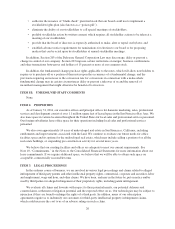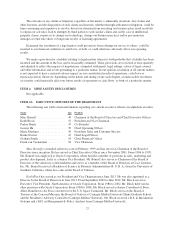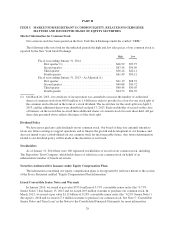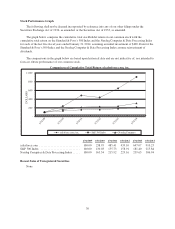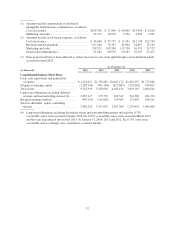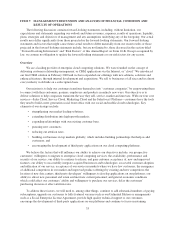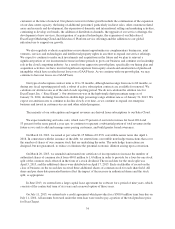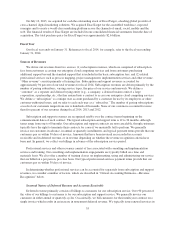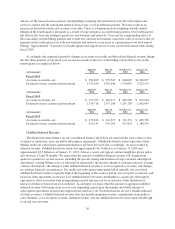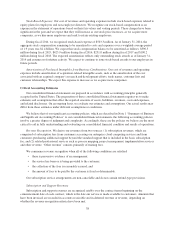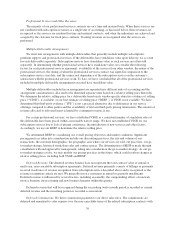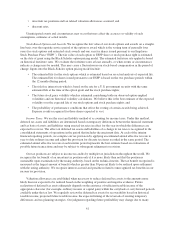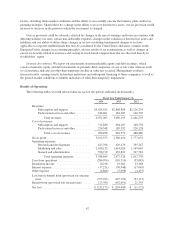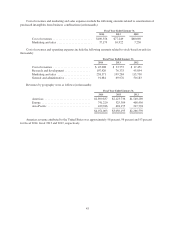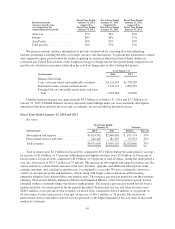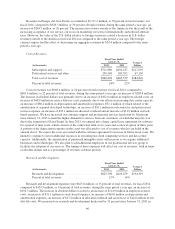Salesforce.com 2014 Annual Report Download - page 40
Download and view the complete annual report
Please find page 40 of the 2014 Salesforce.com annual report below. You can navigate through the pages in the report by either clicking on the pages listed below, or by using the keyword search tool below to find specific information within the annual report.
advance of the renewal service period, and depending on timing, the initial invoice for the subscription and
services contract and the subsequent renewal invoice may occur in different quarters. This may result in an
increase in deferred revenue and accounts receivable. There is a disproportionate weighting towards annual
billings in the fourth quarter, primarily as a result of large enterprise account buying patterns. Our fourth quarter
has historically been our strongest quarter for new business and renewals. Year on year compounding effect of
this seasonality in both billing patterns and overall new and renewal business causes the value of invoices that we
generate in the fourth quarter for both new business and renewals to increase as a proportion of our total annual
billings. Approximately 74 percent of all subscription and support invoices were issued with annual terms during
fiscal 2014.
Accordingly, the sequential quarterly changes in accounts receivable and the related deferred revenue during
the first three quarters of our fiscal year are not necessarily indicative of the billing activity that occurs in the
fourth quarter as displayed below:
(in thousands)
April 30,
2013
July 31,
2013
October 31,
2013
January 31,
2014
Fiscal 2014
Accounts receivable, net ................. $ 502,609 $ 599,543 $ 604,045 $1,360,837
Deferred revenue, current and noncurrent .... 1,733,160 1,789,648 1,734,619 2,522,115
(in thousands)
April 30,
2012
July 31,
2012
October 31,
2012
January 31,
2013
Fiscal 2013
Accounts receivable, net ................. $ 371,395 $ 446,917 $ 418,590 $ 872,634
Deferred revenue, current and noncurrent .... 1,334,716 1,337,184 1,291,703 1,862,995
(in thousands)
April 30,
2011
July 31,
2011
October 31,
2011
January 31,
2012
Fiscal 2012
Accounts receivable, net ................. $ 270,816 $ 342,397 $ 312,331 $ 683,745
Deferred revenue, current and noncurrent .... 915,133 935,266 917,821 1,380,295
Unbilled Deferred Revenue
The deferred revenue balance on our consolidated balance sheet does not represent the total contract value
of annual or multi-year, non-cancelable subscription agreements. Unbilled deferred revenue represents future
billings under our subscription agreements that have not been invoiced and, accordingly, are not recorded in
deferred revenue. Unbilled deferred revenue was approximately $4.5 billion as of January 31, 2014 and
approximately $3.5 billion as of January 31, 2013. Also as a result, our typical contract length has grown and is
now between 12 and 36 months. We expect that the amount of unbilled deferred revenue will change from
quarter to quarter for several reasons, including the specific timing and duration of large customer subscription
agreements, varying billing cycles of subscription agreements, the specific timing of customer renewals, foreign
currency fluctuations, the timing of when unbilled deferred revenue is to be recognized as revenue, and changes
in customer financial circumstances. For multi-year subscription agreements billed annually, the associated
unbilled deferred revenue is typically high at the beginning of the contract period, zero just prior to renewal, and
increases if the agreement is renewed. Low unbilled deferred revenue attributable to a particular subscription
agreement is often associated with an impending renewal and may not be an indicator of the likelihood of
renewal or future revenue from such customer. Accordingly, we expect that the amount of aggregate unbilled
deferred revenue will change from year-to-year depending in part upon the number and dollar amount of
subscription agreements at particular stages in their renewal cycle. Such fluctuations are not a reliable indicator
of future revenues. Unbilled deferred revenue does not include minimum revenue commitments from indirect
sales channels, as we recognize revenue, deferred revenue, and any unbilled deferred revenue upon sell-through
to an end user customer.
36


